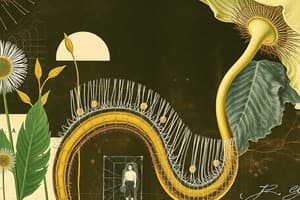Podcast
Questions and Answers
What significant feature distinguishes seed-bearing plants from non-seed plants?
What significant feature distinguishes seed-bearing plants from non-seed plants?
- Production of spores exclusively.
- Absence of vascular tissue.
- Presence of only female gametophytes.
- Reduction of the gametophyte stage. (correct)
Which statement accurately characterizes angiosperms?
Which statement accurately characterizes angiosperms?
- Angiosperms only reproduce through spores.
- Angiosperms are characterized by double fertilization. (correct)
- Angiosperms consist only of non-vascular plants.
- Angiosperms do not produce fruit.
Which of the following best describes the role of the gametophyte in plant reproduction?
Which of the following best describes the role of the gametophyte in plant reproduction?
- The gametophyte produces haploid gametes. (correct)
- The gametophyte provides vascular transport for plants.
- The gametophyte directly produces seeds.
- The gametophyte develops into fruit.
What are the cells that comprise vascular tissue in plants?
What are the cells that comprise vascular tissue in plants?
Which type of seed dispersal method is associated with fruits having spines or hooks?
Which type of seed dispersal method is associated with fruits having spines or hooks?
What process occurs within seed-bearing plants after the male gametophyte is formed?
What process occurs within seed-bearing plants after the male gametophyte is formed?
Which statement is true regarding the dispersal of heavy round fruits?
Which statement is true regarding the dispersal of heavy round fruits?
What unique feature is associated with angiosperms during fertilization?
What unique feature is associated with angiosperms during fertilization?
How are fruits with air bubbles typically dispersed?
How are fruits with air bubbles typically dispersed?
Which of the following statements accurately describes bryophytes?
Which of the following statements accurately describes bryophytes?
Flashcards are hidden until you start studying
Study Notes
Gametophyte
- The gametophyte is the haploid generation of a plant's life cycle, producing gametes (sex cells) through mitosis.
- The gametes fuse to form a diploid zygote that develops into the sporophyte generation.
Bryophytes
- Bryophytes are non-vascular plants that lack specialized tissues for transporting water and nutrients.
- Examples include mosses, liverworts, and hornworts.
Seed Bearing Plants
- Seed bearing plants are characterized by a reduced gametophyte stage and the development of seeds.
- The male gametophyte is represented by pollen grains.
- The female gametophyte resides within the ovule and develops into a seed.
- The outer layers of the ovule develop into a seed coat.
- Seed bearing plants also produce fruits, which aid in seed dispersal.
Plant Groups & Fertilization
- Angiosperms, also known as flowering plants, are the only plant group that produces fruits.
- They have a unique feature of double fertilization, where one sperm fertilizes the egg cell, forming a diploid zygote, and the other sperm fertilizes the polar nuclei, forming a triploid endosperm (nutritive tissue).
Flower Parts
- The ovary of the flower develops into a fruit, which encloses the seed(s).
- The ovules within the ovary develop into seeds.
Seed Dispersal
- Seed dispersal mechanisms are crucial for plant survival and colonization of new areas.
- Fruits with spines or hooks attach to animal fur for dispersal.
- Fruits with high caloric content are dispersed by animals consuming them and excreting the seeds.
- Feathery fruits are adapted for wind dispersal.
- Fruits with air bubbles are dispersed by water currents.
- Heavy, round fruits are dispersed by gravity.
Vascular Tissue
- Xylem and phloem are the primary vascular tissues responsible for transporting water, nutrients, and sugars throughout the plant.
- Tracheids and vessel elements are the specialized cells that make up xylem and phloem.
- Tracheids are long, narrow cells with tapering ends, whereas vessel elements are wider and connected end-to-end to form continuous vessels.
Gametophyte
- Produces haploid gametes, leading to the sporophyte stage
- Sporophyte produces more spores
Bryophytes
- Do not contain vascular transport tissue
Seed Bearing Plants
- Gametophyte stage is reduced, but produces pollen (male gametophyte)
- Produce fruits, which help disperse seeds
Plant Groups & Fertilization
- Angiosperms are the only plant group that produces fruit
- Angiosperms have a unique double fertilization process, which produces a 3N endosperm
Flower Parts
- Ovary develops into fruit
- Ovules develop into seeds
Seed Dispersal
- Fruits with spines, hooks, or high calories are dispersed by animals
- Feathery fruits are dispersed by wind
- Fruits with air bubbles are dispersed by water
- Heavy round fruits are dispersed by gravity
Vascular Tissue
- Xylem and phloem are made up of tracheids and vessel elements
Studying That Suits You
Use AI to generate personalized quizzes and flashcards to suit your learning preferences.




